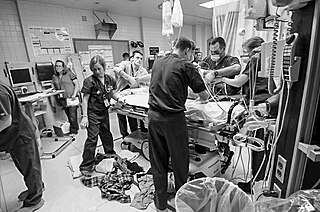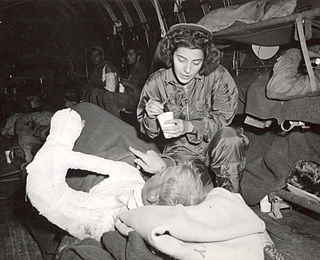Related Research Articles

Emergency medicine is the medical speciality concerned with the care of illnesses or injuries requiring immediate medical attention. Emergency physicians continuously learn to care for unscheduled and undifferentiated patients of all ages. As first-line providers, in coordination with Emergency Medical Services, they are primarily responsible for initiating resuscitation and stabilization and performing the initial investigations and interventions necessary to diagnose and treat illnesses or injuries in the acute phase. Emergency physicians generally practise in hospital emergency departments, pre-hospital settings via emergency medical services, and intensive care units. Still, they may also work in primary care settings such as urgent care clinics.

Medicare is a government national health insurance program in the United States, begun in 1965 under the Social Security Administration (SSA) and now administered by the Centers for Medicare and Medicaid Services (CMS). It primarily provides health insurance for Americans aged 65 and older, but also for some younger people with disability status as determined by the SSA, including people with end stage renal disease and amyotrophic lateral sclerosis.

Medicare is an unofficial designation used to refer to the publicly funded single-payer healthcare system of Canada. Canada's health care system consists of 13 provincial and territorial health insurance plans, which provide universal healthcare coverage to Canadian citizens, permanent residents, and certain temporary residents. The systems are individually administered on a provincial or territorial basis, within guidelines set by the federal government. The formal terminology for the insurance system is provided by the Canada Health Act and the health insurance legislation of the individual provinces and territories.
The Patient Self-Determination Act (PSDA) was passed by the United States Congress in 1990 as an amendment to the Omnibus Budget Reconciliation Act of 1990. Effective on December 1, 1991, this legislation required many hospitals, nursing homes, home health agencies, hospice providers, health maintenance organizations (HMOs), and other health care institutions to provide information about advance health care directives to adult patients upon their admission to the healthcare facility. This law does not apply to individual physicians.

UC Davis Medical Center is part of UC Davis Health and a major academic health center located in Sacramento, California. It is owned and operated by the University of California as part of its University of California, Davis campus. The medical center sits on a 142-acre (57 ha) campus located between the Elmhurst, Tahoe Park, and Oak Park residential neighborhoods. The site incorporates the land and some of the buildings of the former Sacramento Medical Center as well as much of the land previously occupied by the California State Fair until its 1967 move to a new location.

A nurse practitioner (NP) is an advanced practice registered nurse and a type of mid-level practitioner. NPs are trained to assess patient needs, order and interpret diagnostic and laboratory tests, diagnose disease, formulate and prescribe treatment plans. NP training covers basic disease prevention, coordination of care, and health promotion, but does not provide the depth of expertise needed to recognize more complex conditions.
Telepsychiatry is the application of telemedicine to the specialty field of psychiatry. The term typically describes the delivery of psychiatric assessment and care through telecommunications technology, usually videoconferencing. Telepsychiatry services can be offered through intermediary companies that partner with facilities to increase care capacities, or by individual providers or provider groups. Most commonly, telepsychiatry encounters take place at medical facilities under the supervision of onsite staff, though at-home models are becoming accepted as long as they are in compliance with HIPAA standards.

An intensive care unit (ICU), also known as an intensive therapy unit or intensive treatment unit (ITU) or critical care unit (CCU), is a special department of a hospital or health care facility that provides intensive care medicine.
Case management is a managed care technique within the health care coverage system of the United States. It involves an integrated system that manages the delivery of comprehensive healthcare services for enrolled patients. Case managers are employed in almost every aspect of health care and these employ different approaches in the control of clinical actions.
In the United States, anesthesia can be administered by physician anesthesiologists, an anesthesiologist assistant, or nurse anesthetist.

A flight nurse is a registered nurse who specialises in the field of providing comprehensive pre-hospital, emergency critical care, and hospital care to a vast scope of patients. The care of these patients is generally during aeromedical evacuation or rescue operations aboard helicopters, propeller aircraft or jet aircraft. On board a rescue aircraft you would find a flight nurse accompanied by flight medics and respiratory practitioners, as well as the option of a flight physician for comprehensive emergency and critical transport teams. The inclusion of a flight physician is more commonly seen in pediatric and neonatal transport teams. A critical care flight nurse must be able to deal with all age groups with broad critical emergencies. With no physicians on site the nurses scope of practice is expanded. The critical care experience is transferred over to a flight nurse with impacting factors such as altitude and changes in pressure, gravitational forces, and weather. Some patients may experience exacerbation's because of factors related to the cabin environment including hypoxia, limited mobility, gas expansion, and risk of injury related to turbulence and resources with definitive care are limited. Aeromedical evacuation crews coordinate with other organizations to plan for the safe and timely care and evacuation of patients. Crews must be prepared for patients suffering from trauma and mental health illnesses.

A hospital is a health care institution providing patient treatment with specialized health science and auxiliary healthcare staff and medical equipment. The best-known type of hospital is the general hospital, which typically has an emergency department to treat urgent health problems ranging from fire and accident victims to a sudden illness. A district hospital typically is the major health care facility in its region, with many beds for intensive care and additional beds for patients who need long-term care. Specialized hospitals include trauma centers, rehabilitation hospitals, children's hospitals, seniors' (geriatric) hospitals, and hospitals for dealing with specific medical needs such as psychiatric treatment and certain disease categories. Specialized hospitals can help reduce health care costs compared to general hospitals. Hospitals are classified as general, specialty, or government depending on the sources of income received.

Hospice care in the United States is a type and philosophy of end-of-life care which focuses on the palliation of a terminally ill patient's symptoms. These symptoms can be physical, emotional, spiritual or social in nature. The concept of hospice as a place to treat the incurably ill has been evolving since the 11th century. Hospice care was introduced to the United States in the 1970s in response to the work of Cicely Saunders in the United Kingdom. This part of health care has expanded as people face a variety of issues with terminal illness. In the United States, it is distinguished by extensive use of volunteers and a greater emphasis on the patient's psychological needs in coming to terms with dying.

A rural health clinic (RHC) is a clinic located in a rural, medically under-served area in the United States that has a separate reimbursement structure from the standard medical office under the Medicare and Medicaid programs. RHCs were established by the Rural Health Clinic Services Act of 1977, . The RHC program increases access to health care in rural areas by
- creating special reimbursement mechanisms that allow clinicians to practice in rural, under-served areas
- increasing utilization of physician assistants (PA) and nurse practitioners (NP)
Massac Memorial Hospital is a 25-bed general medical and surgical hospital located in Metropolis, Illinois, United States. In 2011, the hospital had 1,002 admissions, 10,031 emergency department visits, and 25,365 outpatient visits.
Aspirus Medford Hospital is a non-profit, primary care health care organization in Taylor and Price Counties in north-central Wisconsin, United States. Headquartered in Medford, Wisconsin, it is composed of a hospital, a continuum of senior care services, therapy centers, a pharmacy, a fitness center and gym, and primary care clinics located in Gilman, Medford, Prentice, Rib Lake, and Phillips, Wisconsin. The organization is partnered with Aspirus in Wausau, Wisconsin. It employs 525 individuals in the region.
The Physician Quality Reporting System (PQRS), formerly known as the Physician Quality Reporting Initiative (PQRI), is a health care quality improvement incentive program initiated by the Centers for Medicare and Medicaid Services (CMS) in the United States in 2006. It is an example of a "pay for performance" program which rewards providers financially for reporting healthcare quality data to CMS.
Deemed status is a hospital accreditation for hospitals in the United States.
A hospital readmission is an episode when a patient who had been discharged from a hospital is admitted again within a specified time interval. Readmission rates have increasingly been used as an outcome measure in health services research and as a quality benchmark for health systems. Generally, higher readmission rate indicates ineffectiveness of treatment during past hospitalizations. Hospital readmission rates were formally included in reimbursement decisions for the Centers for Medicare and Medicaid Services (CMS) as part of the Patient Protection and Affordable Care Act (ACA) of 2010, which penalizes health systems with higher than expected readmission rates through the Hospital Readmission Reduction Program. Since the inception of this penalty, there have been other programs that have been introduced, with the aim to decrease hospital readmission. The Community Based Care Transition Program, Independence At Home Demonstration Program, and Bundled Payments for Care Improvement Initiative are all examples of these programs. While many time frames have been used historically, the most common time frame is within 30 days of discharge, and this is what CMS uses.

The United States has many regions which have been described as medical deserts, regions with inadequate access to one or more kinds of medical services. An estimated 30 million Americans, many in rural regions of the country, live at least 60 minutes drive from a hospital with trauma care services. Limited access to emergency room services, as well as medical specialists, leads to increases in mortality rates and long-term health problems, such as heart disease and diabetes. Regions with higher rates of Medicaid and Medicare patients, as well patients who are uninsured are less likely to live within an hour's drive of a hospital emergency room.
References
- ↑ "Critical Access Hospital Locations - Flex Monitoring Team". flexmonitoring.org. Retrieved 2018-01-31.
- ↑ "Facts about Critical Access Hospital Accreditation | Joint Commission". Archived from the original on 2010-12-12. Retrieved 2016-11-15.
- ↑ "Critical Access Hospitals (CAHs) Introduction - Rural Health Information Hub". ruralhealthinfo.org. Retrieved 2016-11-15.
- ↑ "Critical Access Hospitals (CAHs) Introduction - Rural Health Information Hub". ruralhealthinfo.org. Retrieved 2016-11-15.
- ↑ "State Flex Profiles | National Rural Health Resource Center". ruralcenter.org. Retrieved 2016-11-15.
- 1 2 "42 CFR Ch. IV" (PDF). 2016-10-01. Retrieved 19 April 2019.
- ↑ Freeman, Victoria A.; Walsh, Joan; Rudolf, Matthew; Slifkin, Rebecca T.; Skinner, Asheley Cockrell (2007). "Intensive Care in Critical Access Hospitals". The Journal of Rural Health. 23 (2): 116–123. doi:10.1111/j.1748-0361.2007.00078.x. ISSN 1748-0361. PMID 17397367.
- ↑ "Critical Access Hospitals (CAHs) Introduction - Rural Health Information Hub". ruralhealthinfo.org. Retrieved 2016-11-15.